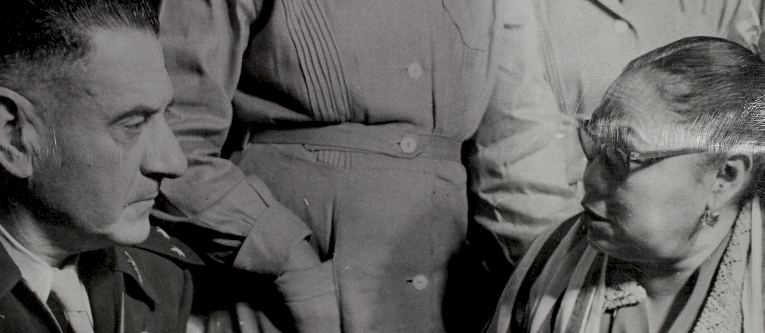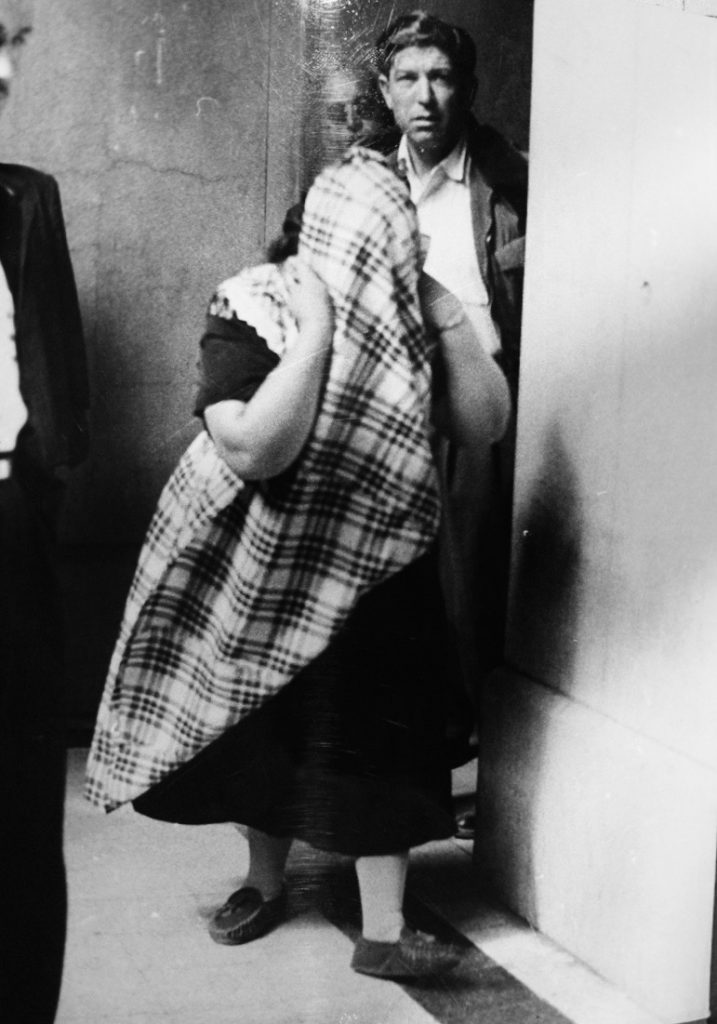- Psychedelics in the Global South: Relevance and Consequences of the Countercultural Movement in Mexico - February 19, 2025
- United Nations on Psychedelics. The World Drug Report 2023 and the Renewed Interest in Psychotropics Substances - August 24, 2023
- Old Uses of Peyote in Traditional Mexican Medicine and its Inclusion in Official Pharmacopeia - July 5, 2023

María Dolores Estévez Zulueta, alias Lola “La Chata” (“Shorty” or “Snub nose”), was born in 1908 in Mexico City, the daughter of Dionisio and Luisa. She grew up in the neighborhood of La Merced, where she became a trader, selling pork scratchings and vegetables at a stall with her mother; but from an early age she realized that there was a business that was every day becoming more profitable: illicit drugs. In time, Lola came to specialize in trafficking a calming, analgesic, and sedative substance: diacetylmorphine, better known as heroin.
In 1898, just ten years before Dolores was born, Bayer Pharmaceuticals had begun marketing heroin for cough relief and as an analgesic substitute for morphine, as diacetylmorphine was thought to be an opioid with great medical potential and less addictive than morphine (Lamour and Lambert, 1972, p. 19). But, less than five years later, various doctors noticed that morphine and other substances could produce dependency, causing what was then called “drug addiction.” As a result, in January 1912 authorities of various countries signed the Hague Convention, marking an international move to restrict certain drugs, in particular suppressing opium, cocaine, morphine, and heroin (Davenport-Hines, 2001, p. 197).
“LOLA CAME TO SPECIALIZE IN TRAFFICKING A CALMING, ANALGESIC, AND SEDATIVE SUBSTANCE: DIACETYLMORPHINE, BETTER KNOWN AS HEROIN.”
The Mexican government approved similar international treaties for repressing drugs and in 1920 promulgated the “Provisions on the cultivation and trade of products that degenerate the race,” which prohibited marijuana, cocaine, opium, morphine, and heroin in the country (Department of Public Health, 1920). By 1929 the production, sale, and consumption of drugs were included among “crimes against public health” in Mexico’s Penal Code, increasing police persecution and imposing punishments such as forced rehabilitation, financial penalties, or imprisonment (Secretary of the Interior, 1929).
Prohibition did not end drug use; by the 1930s marijuana and heroin were the most consumed illegal psychoactive substances in Mexico City. Consequently, a number of entrepreneurs like Lola realized that, despite the risks, the sale of plants and illicit substances was becoming a profitable business.
This article recounts the criminal history of María Dolores Estévez Zulueta, by analyzing criminal records from the Federal District Penitentiary, presently held in the Historical Archive of Mexico City. Together with other documents from Mexico’s General Archive of the Nation, newspaper reports, and scholarly studies, I draw a criminal portrait of the most famous heroin trafficker of the first half of the 20th century: Lola “La Chata.”1
La Chata’s First Arrests 1934–1937
Lola’s first recorded arrest was in 1934 when she was accused of “crimes against public health” at the age of 26. Due to lack of evidence she was released after 48 hours.2 Three years later “Lola La Chata” had become more popular; an operation was carried out in her house on Pradera Street, in La Merced. The agents of the Federal Judicial Police arrested Lola, her brother, and two “addicts,” from whom they seized only two small pieces of heroin, a little marijuana, a bottle cap, a spoon, two droppers, and a syringe, all objects used in the administration of morphine hydrochloride.
La Chata denied the charges and blamed her brother’s guests for bringing the drugs into her house. She claimed that there had been a mistake as near her house there lived a well-known drug dealer called Rosa, who had repeatedly denounced her because Rosa thought La Chata had denounced her the last time she was imprisoned. La Chata also stated that the agent who arrested her “resented her because she does not want to report anyone else.”3 Most of the detainees went to the Federal Hospital for Drug Addicts,4 with the exception of La Chata, who according to the reports was instead taken to the Lecumberri Penitentiary. However, she was released after nine days by the 3rd District Judge in Criminal Matters due to lack of proof.5
Join Chacruna’s Studies in Psychedelic Justice
Drugs and Corruption in the Campaign against Drug Addiction 1937–1938
In April 1938, Luis Huesca de la Fuente, who until then had served as chief of the Narcotics Police of the Department of Public Health,6 was imprisoned in Lecumberri and accused of abuse of authority, perjury, and crimes against public health.7 Ultimately, he was accused of protecting Lola La Chata, who was alleged to have shared her earnings with him.
Leopoldo Salazar Viniegra, who was in charge of the National Campaign against Alcoholism and Drug Addiction, intervened. Salazar was an eminent psychiatrist from Durango, who conducted studies on marijuana, heroin, opium, benzedrine, alcohol, and other substances; he opted for a drug policy in which consumers were treated from a health perspective and were not criminalized. However, although the doctor saw drug addicts capable of rehabilitation, he did not think the same of traffickers.8
When Leopoldo Salazar heard about Luis Huesca’s arrest and his ties to Lola, he published a letter in the El Universal newspaper directed to Lola, warning her that he was the new official prosecuting drug smugglers. Salazar praised her success with drug addicts, her talent “to know how to maintain her position, simply gaining the compliance of all the police” and her business acumen. The psychiatrist did not hide his displeasure and a certain “class prejudice” towards Lola, when he wrote that “she had not been born under the invocation of Venus” and reviled “the roundness of her body,” which he attributed to the sale of tacos, the trafficking of drugs, and police persecution. Salazar added that since the area of La Merced was her territory, most of her clients must come from “the lower town,” referring to this commercial and popular neighborhood very close to downtown. In addition, he stated that Mexican society was undergoing a social transformation to get rid of “seditious traffickers” and that he wanted to discuss these topics with her soon.9 Lola ignored him, and her earnings increased.
Meanwhile, the press announced that the former official “Captain Huesca is in the penitentiary”10: “Chief of the Narcotics Police arrested. He stole a large amount of cocaine. This drug was collected from a woman, and he exchanged it for bicarbonate.”11 Huesca responded to the article calling it “slander and intrigues.” He found some agents “were biting” and he disagreed with Salazar Viniegra, saying: “the doctor had a grudge against me, and this is the result.”12 Luis de la Huesca spent a few days in Lecumberri before an expert chemical report indicated that “the consigned drug is not a drug” and that in reality it was “a chlorinated antiseptic substance”; he was released on bail for the crimes of abuse of authority and perjury.13
Discover the Indigenous Reciprocity Initiative of the Americas
The Number One Enemy of Mexico—The Emergency Laws of 1945
Under the pretext of World War II, the government of Manuel Ávila Camacho promulgated an “emergency law.” Purportedly due to an increasing number of individuals dedicated to “immoral trafficking,” legal rights were suspended for any person who violated the drug laws (Executive Power, 1945). Apparently, the first person to whom this rule was applied was precisely Dolores Estévez, La Chata, who was at that time considered public enemy number one by Mexican authorities.
At the beginning of July 1945, La Chata was apprehended outside her house in La Merced and sent to Islas Marias prison, on an island located off the country’s west coast. In response, Lola sent a telegram to President Ávila Camacho and his wife, Soledad Orozco de Ávila, denying the charges against her.
She instead argued that the police authorities had tried to influence the presidential couple based on rumors, since she “luckily won the lottery and multiplied money with sacrifices and honest business.” She claimed that these profits helped people in her neighborhood by giving them clothes, food, candies, and toys. Moreover she was “innocent of the charges against her”; “evil people” had abused her name. Her first husband Juan Morales had been arrested for drug trafficking, but he died ten earlier. She had nothing to do with contraband goods and the police had persecuted her unjustly.14 The presidential office never responded and Lola remained in prison until March 1946.
El Mesón del Paraíso, 1947
Nestled in the heart of the Tepito neighborhood, was a drug “injection site”: the famous Mesón del Paraíso (Paradise Inn). Although in operation for over a decade, the police carried out periodic raids, making apprehensions of substance users and seizing drugs.
“NESTLED IN THE HEART OF THE TEPITO NEIGHBORHOOD, WAS A DRUG ‘INJECTION SITE’: THE FAMOUS MESÓN DEL PARAÍSO (PARADISE INN). ALTHOUGH IN OPERATION FOR OVER A DECADE, THE POLICE CARRIED OUT PERIODIC RAIDS, MAKING APPREHENSIONS OF SUBSTANCE USERS AND SEIZING DRUGS.”
On January 31, 1947, five Federal Judicial Police agents reported that they had located marijuana, heroin, hypodermic needles, and arrested several “addicts.” The detainees in turn accused La Chata of being one of the main drug distributors in Mexico City. An arrest order was issued for “Lola la Chata,” Antonio García Rojas alias “El Venado” (“The Stag”) and “El Sargento” (“The Sergeant”), as well as for Señora Jova Orozco and Petra García Rojas, wife and sister respectively of “El Venado.”
This was nothing new for Lola. In response to the claims made by the Mesón del Paraíso detainees, her lawyer, Señor Pacho Herrera, countered that the accusations were false. He insisted that her rights had been violated because she was targeted for arrest without proof of possession, consumption, supply, or trafficking of seeds, plants, or illicit substances. But since La Chata had a criminal record, she remained imprisoned for two months until she was released on $10,000 bail.15
Duel in the Underworld! Final Arrest and Death, 1957–1959

By the 1950s, police called Lola the “Drug Empress.” Her fame was such that she was already known beyond the Mexico’s Borders, she was on the sights of Harry Anslinger and the American Beatnik writer William Burroughs, called her the “Aztec goddess.” The press marveled at her abilities. Her vast network of narcotics distributors throughout the city revealed her brazen and corrupt dealings with high-ranking officials.
Lola La Chata moved again, this time to the south of the city in the neighborhood of Prado Churubusco. In 1957 Commander Armando Valderraín arrested La Chata along with 30 people, her supposed gang of “poisoners” (Macías, 2017). The newspapers headlines declared “Poor little Lola. The fingers of the well-manicured hands are covered with ostentatious and extremely valuable jewels,”16 “The well-known trafficker of ‘artificial dreams’ tries to pass herself off as a drug addict,”17 and “a large amount of money, weapons and drug bottles were seized from her.”18
Lola La Chata received a 15-year sentence in the Lecumberri Penitentiary, where she died in 1957 (Macías, 2017). Dolores Estévez Zulueta presided over the drug market in the Mexican capital for almost 30 years. As a woman she shattered gendered expectations and subverted masculine schemes by becoming a leading figure in drug trafficking (Carey, 2009, p. 63). Although the “Empress of the Underworld” died in prison and her empire came to an end, drug trafficking in Mexico City expanded during the following decades.

This article was first published in Spanish: “Lola “La Chata”. La primera gran traficante de narcóticos en la Ciudad de México (1934-1959).”
Notes
1 Despite the fame of Dolores Estevés there are few studies on the history of drugs that have dealt with this important trafficker. For example, see: Pérez Montfort (1997, 2016); Carey (2009, 2014), Astorga (2015).
2 Archivo Histórico de la Ciudad de México (AHCDMX), fondo Cárceles, Penitenciaría, caja 203, exp. 3820.
3 AHCDMX, fondo Cárceles, Penitenciaría, caja 358, exp. 3496.
4 In relation to the Hospital for Drug Addicts [Hospital del Toxicómanos] see Olguín (1995), Pérez Montfort (2016); Bautista (2016).
5 AHCDMX, fondo Cárceles, Penitenciaría, caja 358, exp. 3496.
6 In relation to the Narcotics Police see Pérez Ricart y Olvera (2021).
7 “Comenzó a declarar el capitán de la Fuente”, en Excélsior, Mexico City, April 14, 1938.
8 For a biography of Leopoldo Salazar Viniegra, see Ocaña y Olvera (2018).
9 Leopoldo Salazar Viniegra, “Carta abierta a Lola La Chata”, El Universal, Mexico City, march 11, 1938.
10 “El capitán Huesca esta en la Penitenciaría”, El Universal, Mexico City, April 1, 1938.
11 “Jefe de la Policía de Narcóticos, preso”, El Universal, Mexico City, April 1,1938.
12 “Comenzó a declarar el capitán”, Excélsior, Mexico City, 14 de abril 1938.
13 “Luis Huesca de la Fuente, abuso de autoridad, falsedad de declaraciones y contra la salud”, 1938, AHCDMX, Cárceles, Penitenciaría, caja 402, exp. 1304.
14 Archivo General de la Nación (AGN), Presidentes, Miguel Ávila Camacho, caja 0818, exp. 549.44/1006.
15 “Dolores Estévez Zulueta, contra la salud”, 1947, AHCDMX, Cárceles, Penitenciaría, caja 1014, exp. 1864.
16 La pobrecita Lola”, La Prensa, Mexico City, April 1,1957.
17 “Trata de Hacerse”, La Prensa, Mexico City, April , 1957.
18 Los Sabuesos, La Prensa, Mexico City, april 1, 1957.
References
Archivo General de la Nación (AGN), Presidentes, Miguel Ávila Camacho.
Archivo fotográfico que perteneció al periódico La Prensa. Colección Particular.
Archivo Histórico de la Ciudad de México (AHCDMX), Cárceles, Penitenciaría.
Astorga, L. (2005) El siglo de las drogas. El narcotráfico, del Porfiriato al nuevo milenio. (México: Plaza Janés).
Bautista Hernández, L. (2016). De la Penitenciaría al Manicomio. El proceso de institucionalización del Hospital Federal de Toxicómanos de la Ciudad de México, 1926-1948. [Tesis de Maestría en Historia Moderna y Contemporánea, Instituto Mora].
Burroughs, W. Yonqui. (1997[1953]). (Barcelona: Anagrama).
Carey, E. (2009). “Selling is more of a habit than using” Narcotraficante Lola la Chata and her threat to civilization, 1930-1969. Journal of Women ́s History, 21 (2), 62-89.
Carey, E. (2014). Women drug traffickers. Mules, Bosses and Organized Crime. (Albuquerque: University of New Mexico Press).
Davenport-Hines, R. (2001). La búsqueda del olvido. Historia global de las drogas, 1500-2000, (Madrid: Fondo de Cultura Económica, Turner).
Departamento de Salubridad Pública (1920, marzo 15), Disposiciones sobre el comercio de productos que pueden ser utilizados para fomentar vicios que degeneren la raza, y sobre el cultivo de plantas que pueden ser empleadas con el mismo fin, Diario Oficial de la Federación, (México).
El Universal
Excélsior
Lamour C. y Lambert, M. (1972). La Nueva Guerra del Opio. (Barcelona: Barral).
La Prensa
Macías, L. (2017, Julio 19). “Lola la Chata”, huésped asidua de Lecumberri”. La Prensa. https://www.la-prensa.com.mx/archivos-secretos/lola-la-chata-huesped-asidua-de-lecumberri-3538449.html
Ocaña Salazar, M. y Olvera Hernández, M. (2018). El psiquiatra que luchó contra los cuerdos para despenalizar las drogas. Chacruna Latinoamérica. https://chacruna-la.org/el-psiquiatra-que-lucho-contra-los-cuerdos-para-despenalizar-las-drogas/
Olguín Alvarado, P. (1995). Aproximación a la Historia del Hospital de Toxicómanos (1931-1949). Cuadernos para la historia de la salud.(México: Secretaría de Salud).
Pérez Montfort, R. (1997). El veneno “faradisíaco” o el olor a tortilla tostada. Fragmentos de historia de las “drogas” en México 1870-1920”, en R. Pérez Montfort (coord.), Hábitos, normas y escándalo. Prensa, criminalidad y drogas durante el porfiriato tardío. México: Plaza y Valdés, Centro de Investigaciones y Estudios Superiores en Antropología Social.
Pérez Montfort, R. (2016). Tolerancia y prohibición: aproximaciones a la historia social y cultural de las drogas en México 1840-1940. (México: Colección Debate, Penguin Random House Grupo Editorial).
Pérez Ricart, C. A., & Olvera Hernández, N. A. (2021). Ascenso y declive de la Policía de Narcóticos del Departamento de Salubridad Pública en México (1917-1960). Historia Mexicana, 70 (4), 1661–1714.
Poder Ejecutivo, (1945, mayo 12), Decreto que declara Ley de Emergencia el capitulo 1o, titulo 7o, libro 2o del Código Penal. Diario Oficial de la Federación, (México).
Schievenini, D. (2013), La prohibición de las drogas en México (1912-1929). URVIO. Revista Latinoamericana de Seguridad Ciudadana, 14, 57-68.
Secretaría de Gobernación (1929, noviembre 5), Código Penal para el Distrito y Territorios Federales, Diario Oficial de la Federación, (México).
Take a minute to browse our stock:
Did you enjoy reading this article?
Please support Chacruna's work by donating to us. We are an independent organization and we offer free education and advocacy for psychedelic plant medicines. We are a team of dedicated volunteers!
Can you help Chacruna advance cultural understanding around these substances?
















